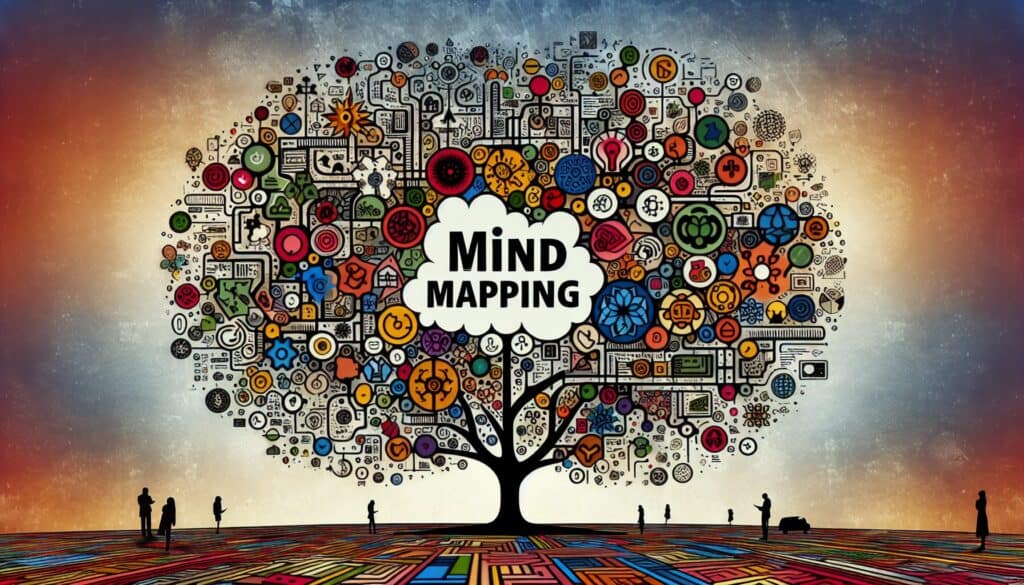To visually organize information, ideas, and concepts around a central topic, facilitating brainstorming, learning, and problem-solving.
- المنهجيات: العملاء والتسويق, الاقتصاد, تصميم المنتج
Mind Mapping

Mind Mapping
- العصف الذهني, الإبداع, التفكير التصميمي, الأفكار, ابتكار, إدارة المشاريع, البحث والتطوير, تصميم يركز على المستخدم, التصميم المرئي
الهدف:
كيفية استخدامه:
- Starts with a central idea or keyword. Related ideas, words, and concepts branch out from the center in a non-linear, graphical way, using colors, images, and keywords to create associations.
الايجابيات
- Enhances creativity and idea generation; Improves memory and recall by using visual cues; Helps to see connections and relationships between different pieces of information; Flexible and adaptable to various topics.
سلبيات
- Can become cluttered and difficult to read if too much information is added; May be too unstructured for individuals who prefer linear thinking; Effectiveness can depend on the individual's visual thinking skills.
الفئات:
- الأفكار, حل المشكلات, تصميم المنتج, إدارة المشاريع
الأفضل لـ
- Brainstorming new ideas, note-taking, planning projects, studying complex topics, and organizing thoughts.
Mind Mapping, as a visual thinking tool, finds its primary applications in diverse fields such as education, project management, and engineering design, facilitating collaborative creativity among teams. This methodology is particularly useful during the ideation phase of product development, where stakeholders from different domains—such as designers, engineers, marketers, and end-users—contribute to the initial brainstorming sessions, allowing for a broad spectrum of ideas to surface and be documented in a cohesive manner. Industries like software development and healthcare use Mind Mapping to break down intricate processes into manageable components, allowing for better planning and execution of projects, while educators rely on it to simplify complex subjects for students. The adaptability of Mind Mapping also allows for its use in agile methodologies, where iterative development requires continuous input and refinement of ideas. Participants in such sessions typically include team members from various departments, fostering interdisciplinary collaboration that can lead to innovative solutions. Mind Maps can serve as living documents that evolve throughout the project lifecycle, becoming a reference point for ideas discussed during meetings and workshops, ensuring that no valuable concepts are overlooked as the project advances. The tool’s capability to incorporate images and colors adds an engaging element that maintains interest and promotes retention, making it particularly useful when addressing multifaceted topics that require a fresh approach or reconsideration of established ideas.
الخطوات الرئيسية لهذه المنهجية
- Identify a central idea or keyword.
- Branch out related ideas and concepts from the central node.
- Use keywords, images, and colors for visual distinction.
- Connect branches to show relationships and hierarchies.
- Add sub-branches for further detail and ideas.
- Review and refine the map by reorganizing and editing elements.
- Iterate on the map as new ideas emerge.
نصائح للمحترفين
- Incorporate digital mind mapping tools that support collaborative features, allowing teams to contribute ideas in real-time and enhance collective brainstorming.
- Utilize different shapes and icons to signify varying levels of importance or categories, enabling quick visual differentiation and prioritization of concepts.
- Conduct periodic reviews of mind maps to refresh and adapt ideas, promoting continuous evolution and ensuring relevance to ongoing projects.
لقراءة عدة منهجيات ومقارنتها, نوصي باستخدام
> مستودع المنهجيات الشامل <
مع أكثر من 400 منهجية أخرى.
نرحب بتعليقاتكم على هذه المنهجية أو المعلومات الإضافية على قسم التعليقات أدناه ↓، وكذلك أي أفكار أو روابط متعلقة بالهندسة.
السياق التاريخي
1960
1980
1983
1990
1995
2000
2010
1950
1980
1980
1986
1994
1995
2000
(إذا كان التاريخ غير معروف أو غير ذي صلة، على سبيل المثال "ميكانيكا الموائع"، يتم تقديم تقدير تقريبي لظهوره الملحوظ)














منشورات ذات صلة
استبيانات الانزعاج العضلي الهيكلي
الاختبار متعدد المتغيرات (MVT)
تحليل الانحدار المتعدد
أنظمة التقاط الحركة
طريقة MoSCoW
اختبار متوسط المزاج